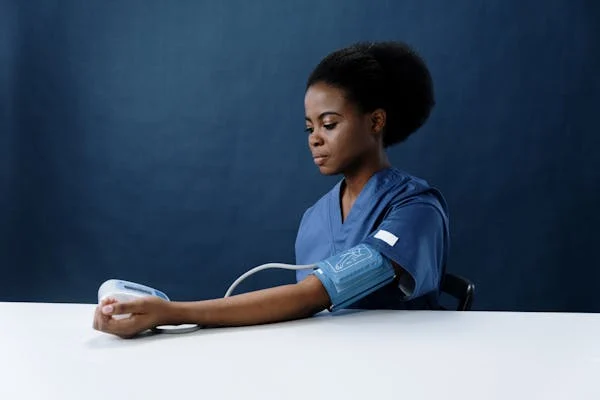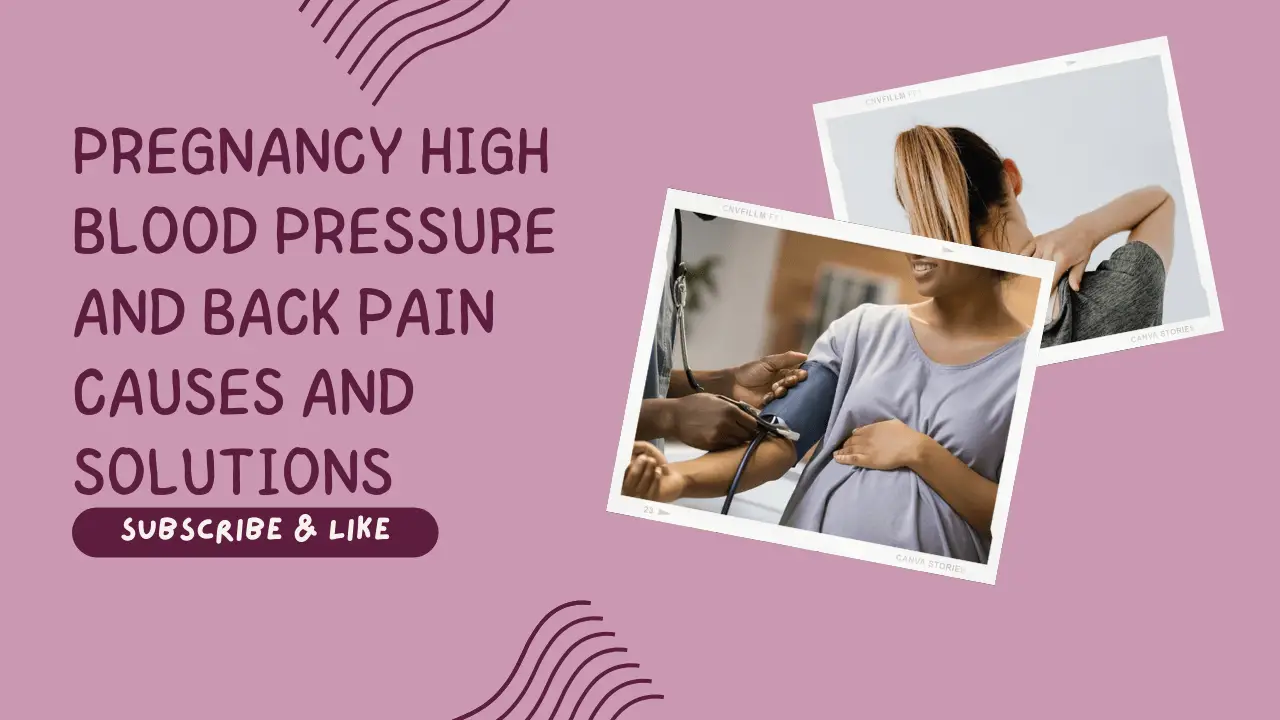Pregnancy often brings a host of physical changes, and among the common issues that expectant mothers face are pregnancy high blood pressure and back pain. These ailments can have an effect on a woman’s general health and well-being in addition to her comfort.
If pregnancy high blood pressure is not appropriately managed, it can lead to significant concerns, including gestational hypertension and preeclampsia.
Meanwhile, weight growth, changing posture, and hormone fluctuations all contribute to the common complaint of back pain.
A healthier pregnancy experience depends on knowing the causes of these disorders and practical remedies. We will discuss the causes of pregnancy high blood pressure and back pain in this blog post, along with some doable remedies.

Pregnancy High Blood Pressure and Back Pain:
Pregnancy can bring about numerous physical changes, with pregnancy high blood pressure and back pain being among the more challenging conditions. These issues often occur simultaneously and can significantly affect a woman’s comfort and health during pregnancy.
Pregnancy High Blood Pressure
Pregnancy high blood pressure, also known as gestational hypertension or preeclampsia, is a condition characterized by elevated blood pressure levels during pregnancy. This condition can develop after the 20th week of pregnancy and may lead to serious complications if not monitored and managed effectively.
- Types of Pregnancy High Blood Pressure:
- Gestational Hypertension: Elevated blood pressure that develops after 20 weeks of pregnancy but without other symptoms.
- Preeclampsia: A more severe form that includes high blood pressure and signs of damage to organs such as the kidneys or liver, often accompanied by protein in the urine.
- Symptoms and Risks:
- Common symptoms include headaches, swelling, and visual disturbances.
- Untreated, pregnancy high blood pressure can lead to complications such as preterm birth, low birth weight, and in severe cases, eclampsia, which can be life-threatening.
Back Pain During Pregnancy
Back pain is another prevalent issue, affecting many pregnant women due to the physical changes that occur during this period. As the body adjusts to support the growing baby, several factors contribute to back pain.
- Common Causes:
- Hormonal Changes: Increased levels of relaxin hormone soften ligaments, which can lead to instability in the spine.
- Weight Gain: The added weight from the growing baby and increased fluid retention places extra stress on the back muscles and spine.
- Postural Changes: The shift in the center of gravity forces women to adjust their posture, which can strain the back.
- Impact and Management:
- Back pain can vary from mild discomfort to severe pain affecting daily activities.
- Effective management strategies include maintaining proper posture, engaging in safe exercises, and using ergonomic support.
Understanding pregnancy high blood pressure and back pain is crucial for developing effective management strategies and ensuring both maternal and fetal health. Addressing these issues proactively can help minimize discomfort and prevent complications during pregnancy.
Causes of Pregnancy High Blood Pressure:
Pregnancy High Blood Pressure and Back Pain can be interconnected, as both are influenced by various factors. Here’s a detailed look at the causes of high blood pressure during pregnancy:

- Genetic and Pre-existing Conditions:
- Women with a family history of high blood pressure or preeclampsia are at increased risk.
- Pre-existing conditions such as chronic hypertension or kidney disease can predispose individuals to develop high blood pressure during pregnancy.
- Lifestyle Factors:
- Diet: High sodium intake and poor nutrition can contribute to elevated blood pressure.
- Obesity: Excessive weight gain before and during pregnancy can increase the risk of developing high blood pressure.
- Physiological Changes:
- Placental Issues: Abnormalities in the placenta can affect blood flow and contribute to high blood pressure.
- Hormonal Changes: Fluctuations in hormones like progesterone can impact blood vessel function and pressure.
- Other Factors:
- Multiple Pregnancies: Carrying more than one baby increases the risk of developing high blood pressure.
- Age: Women who are younger than 20 or older than 35 are at higher risk.
Causes of Back Pain During Pregnancy:
Back pain is a common issue during pregnancy, and its causes are multifaceted:
- Hormonal Changes:
- The hormone relaxin is released to loosen the ligaments in the pelvis for childbirth. While necessary, this also leads to increased instability in the spine and lower back.
- Weight Gain:
- The growing baby, increased blood volume, and fluid retention add weight, which puts extra pressure on the back muscles and spine.
- Postural Changes:
- As the pregnancy progresses, the center of gravity shifts forward. This shift causes women to alter their posture, which can strain the back muscles and lead to pain.
- Muscle and Ligament Strain:
- Increased Load: The additional weight causes the back muscles to work harder, leading to fatigue and discomfort.
- Weak Core Muscles: Insufficient strength in the abdominal muscles can contribute to back pain by failing to support the spine adequately.
- Stress and Emotional Factors:
- Emotional stress can lead to muscle tension and exacerbate back pain.
By recognizing these causes, pregnant women can better understand their symptoms and work with healthcare providers to develop effective strategies to manage and alleviate both pregnancy high blood pressure and back pain.
Solutions for Managing Pregnancy High Blood Pressure:
Pregnancy High Blood Pressure and Back Pain often require tailored approaches to manage both conditions simultaneously. Here are some solutions specifically for managing high blood pressure during pregnancy:

- Dietary Changes:
- Reduce Sodium Intake: Limiting salt can help control blood pressure levels. Opt for fresh, whole foods and avoid processed items high in sodium.
- Balanced Nutrition: Incorporate a diet rich in fruits, vegetables, lean proteins, and whole grains. Foods high in potassium, such as bananas and spinach, can help manage blood pressure.
- Regular Monitoring:
- Blood Pressure Checks: Regular monitoring is essential to detect any fluctuations early and manage them effectively. Follow your healthcare provider’s recommendations for frequency and methods.
- Exercise:
- Safe Activities: Engage in moderate, doctor-approved exercises like walking or swimming, which can improve circulation and reduce blood pressure.
- Stress Reduction: Activities such as yoga or gentle stretching can help lower stress levels, which can positively affect blood pressure.
- Medical Interventions:
- Medications: In some cases, medications may be prescribed to manage high blood pressure. Always follow your healthcare provider’s instructions and avoid self-medicating.
- Lifestyle Adjustments:
- Rest and Relaxation: Ensure adequate rest and practice relaxation techniques to manage stress, which can help in controlling blood pressure.
Solutions for Managing Back Pain:
Addressing back pain during pregnancy involves strategies that target the physical changes and stress factors contributing to discomfort:
- Exercise and Physical Therapy:
- Strengthening Exercises: Focus on exercises that strengthen the core and back muscles. Safe activities include pelvic tilts, cat-cow stretches, and modified squats.
- Physical Therapy: Professional guidance can provide personalized exercises and techniques to relieve back pain and improve posture.
- Ergonomic Adjustments:
- Proper Posture: Maintain good posture when sitting and standing. Use supportive chairs and avoid prolonged periods of sitting or standing.
- Supportive Gear: Consider using a maternity support belt or cushion to help alleviate strain on the back.
- Pain Relief Techniques:
- Heat and Cold Therapy: Applying heat or cold packs can provide temporary relief from back pain.
- Massage Therapy: Gentle massage by a trained therapist can help relax tense muscles and improve blood flow.
- Stress Management:
- Relaxation Techniques: Practice stress-reducing methods such as deep breathing, meditation, and prenatal yoga. Managing stress can help reduce muscle tension and back pain.
- Lifestyle Modifications:
- Weight Management: Aim to maintain a healthy weight gain within the recommended range for pregnancy to reduce extra strain on the back.
- Sleep Position: Sleep on your side with a pillow between your knees to reduce back strain.
By implementing these solutions, women can effectively manage pregnancy high blood pressure and back pain, leading to a more comfortable and healthier pregnancy experience. Regular consultation with healthcare providers ensures that these strategies are appropriately tailored and monitored throughout pregnancy.
Prevention of Pregnancy High Blood Pressure and Back Pain:
Pregnancy High Blood Pressure and Back Pain can be mitigated through various preventive strategies:
- Healthy Lifestyle Choices:
- Balanced Diet: Eating a nutrient-rich diet with low sodium and high potassium can help manage blood pressure levels. Make sure to include a lot of nutritious fruits, vegetables, whole grains, and lean proteins.
- Regular Exercise: Engage in moderate, pregnancy-safe exercises such as walking, swimming, or prenatal yoga. Exercise helps maintain a healthy weight and can alleviate back pain by strengthening muscles and improving posture.
- Weight Management:
- Healthy Weight Gain: Follow guidelines for weight gain during pregnancy to avoid excessive strain on the back and to reduce the risk of developing high blood pressure. Monitor weight gain regularly and consult with your healthcare provider to stay within recommended limits.
- Stress Reduction:
- Stress Management Techniques: Practice relaxation techniques such as deep breathing, meditation, and prenatal yoga. Managing stress effectively can help lower blood pressure and reduce muscle tension contributing to back pain.
- Proper Posture and Ergonomics:
- Ergonomic Adjustments: Use supportive furniture and maintain good posture. Avoid standing or sitting for prolonged periods and use pillows or support belts to alleviate back strain.
Monitoring Pregnancy High Blood Pressure and Back Pain:
Regular monitoring is crucial for early detection and effective management of both pregnancy high blood pressure and back pain:
- Blood Pressure Monitoring:
- Regular Check-ups: Attend all scheduled prenatal appointments where your blood pressure will be monitored. Regular checks help identify any elevations early and allow for timely intervention.
- Home Monitoring: If recommended by your healthcare provider, use a home blood pressure monitor to track your levels between appointments. Report any significant changes or concerns promptly.
- Tracking Back Pain Symptoms:
- Symptom Diary: Keep a record of your back pain symptoms, including their intensity, duration, and any potential triggers. This information can help your healthcare provider tailor effective management strategies.
- Consultations: Discuss any persistent or worsening back pain with your healthcare provider to rule out any underlying issues and to adjust your treatment plan if necessary.
- Regular Prenatal Visits:
- Comprehensive Exams: Regular visits ensure that both your blood pressure and back pain are evaluated in the context of your overall health. Your healthcare provider can offer personalized advice and adjust treatment plans as needed.
- Education and Awareness:
- Stay Informed: Educate yourself about the signs of high blood pressure and back pain. Knowing when to seek help is crucial for preventing complications.
- Support Systems: Engage with support networks, including prenatal classes and counseling services, to stay informed and supported throughout your pregnancy.
By implementing preventive measures and maintaining vigilant monitoring, you can effectively manage pregnancy high blood pressure and back pain, contributing to a healthier and more comfortable pregnancy experience.
Conclusion:
In summary, proactive management of high blood pressure and back discomfort during pregnancy necessitates preventive measures and routine monitoring. You can lessen these typical pregnancy problems by eating a balanced diet, exercising safely, and keeping good posture. Regular examinations and efficient stress reduction are also essential.
Using these methods to treat back pain and high blood pressure during pregnancy will contribute to a more comfortable and healthy pregnancy. Click to learn more.
FAQs:
- What are the symptoms of pregnancy high blood pressure? Pregnancy high blood pressure symptoms include severe headaches, swelling in the hands and feet, sudden weight gain, and visual disturbances. It’s important to monitor these symptoms and consult a healthcare provider.
- How can I prevent back pain during pregnancy? Prevent back pain by maintaining good posture, using ergonomic support, engaging in gentle exercises, and avoiding heavy lifting. Wearing a supportive belt can also help.
- What is the best way to manage pregnancy high blood pressure? Manage pregnancy high blood pressure by eating a low-sodium, balanced diet, exercising regularly, monitoring your blood pressure, and following your healthcare provider’s recommendations for any prescribed medications.
- When should I seek medical help for back pain during pregnancy? Seek medical help if your back pain is severe, persistent, or accompanied by symptoms such as numbness, tingling, or difficulty walking. These could indicate a more serious condition.
- Can exercise help with pregnancy high blood pressure and back pain? Yes, exercise can help manage both pregnancy high blood pressure and back pain by improving circulation, reducing stress, and strengthening muscles. Ensure you follow exercises that are safe and approved by your healthcare provider.
